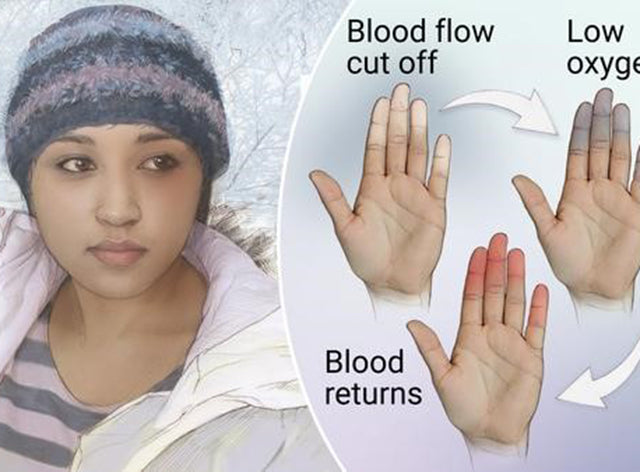
Living with Raynaud’s Disease: Practical Tips from a Long-time Sufferer
It's Raynaud's Awareness Week, and it's no accident that if falls during the coldest month of the year: February! If you struggle to keep your hands and feet warm, even when the weather isn’t so cold (I wear socks 10 out of 12 months a year), you may be suffering from Raynaud’s Disease. I have lived with this disease for over twenty years, and I want to inform you about what it is, why it happens and what you can do about it. This information is adapted from the NHS and Scleroderma and Raynaud's UK
What is Raynaud’s and what are some of the symptoms
Raynaud’s Disease is a blood circulation-related medical concern. It means that your extremities (hands and feet) do not receive proper circulation like the rest of your body does.
As a result of this, your fingers or feet can sometimes feel cold, numb, filled with 'pins and needles' sensation, and painful. They may even lose colour or sensation—despite wearing gloves or socks.
This contrasts with the rest of your body, which feels fine in comparison. This disease affects up to 10 million people in the UK, but many are in the dark that they even have a condition that needs to be treated with care.
Why does this happen?
When exposed to cold temperatures, it is normal for our blood vessels to become narrower. However, in a person with Raynaud’s Disease, the narrowing of the blood vessels is extreme.
As a result, normal blood flow, which we need for warmth, is severely constricted. This happens to parts of the body that are isolated from our main organs. The hands, feet, nipples and even ears commonly suffer from extreme narrowing of blood vessels when exposed to cold.
What triggers a Raynaud’s response?
In addition to exposure to cold temperatures (including water), emotional distress (anxiety, trauma, fear) can also be a trigger for a Raynaud’s attack. Women are also more susceptible to suffering from Raynaud’s. Those of us with darker skin can suffer to the extent that we see our skin lose colour in areas attacked by Raynaud’s, whereas lighter skin will turn pink or even purple.
What are the dangers and how is it diagnosed?
If the above descriptions sound familiar to you, see your GP for a proper diagnosis. The earlier the better too because Raynaud’s presents more commonly before the age of 30. I have suffered with this disease since I was a teenager, but only in my 20s did I come to know what was happening to me was a disease.
Lack of attention to Raynaud’s not only causes ongoing distress in the mind and body, but more severe forms can lead to things like ulcers in the fingers. Though less common, Raynaud’s detection can also be an early indicator of a more serious concerns such as rheumatoid arthritis, lupus or other autoimmune disease. It is important to get diagnosed so that you can learn how to treat it.
Treatments & Practical Tips for Living with Raynaud’s
If diagnosed with Raynaud’s, there is medication to help improve your circulation, which you should learn about from your GP or specialist. However, there are very practical things which can help you avoid the pain and distress of a Raynaud’s attack.
| Do | Don't |
| Keep your home warm and work environment warm. If this is costly, do so for rooms in which you spend the most time | Smoking already leads to the narrowing of our blood vessels, which is the enemy of Raynaud’s. Help yourself by limiting things that artificially narrow blood vessels |
| Wear layers, with extra protective clothing on your hands and feet | Ingest too much caffeine. An abundance of caffeinated drinks and food (chocolate included!) can also contribute to narrow blood vessels |
| Exercise regularly to improve circulation | |
| Practice breathing exercises, including yoga | |
| Eat a balanced diet not too heavy on caffeine |
My practical Raynaud's advice
- Mittens are better than gloves. Gloves separate the fingers making them individually vulnerable to the cold. But mittens encourage the fingers and palm to pool the resources of their meagre body heat, thus decreasing their exposure to the cold. It is also easier to make a fist inside your mittens which helps promote body heat. Sheepskin mittens are wonderful, but vegan alternatives will also work well.
- Do not wash your hands with cold or cool water. This encourages a Raynaud’s sneak attack, even if you don’t feel it immediately.
- Speaking of washing– natural soap or sulphate-free body wash is better than many commercially made soaps. This is because sulphate-free soaps and body washes contain more refatting ingredients (things that mitigate dryness). Cleansers with more natural ingredients avoid drying out your skin because they will not be too harsh. Dry, tight skin makes Raynaud's worse.
- Dry hands and feet are a no-no. Always moisturise your hands and feet with a rich lotion or cream after washing them with warm water. The moisturiser acts as a thin layer of protection, reducing direct exposure to cold

- If you work at a register or in a cold office, wrist warmers are you best friends! Although the fingers remain exposed, by warming the wrists, the blood vessels begin gradually opening up down into the palms and then the fingers. I swear it’s like magic…or rather, science!

- If you are having an intense attack wherein your fingers and/or feet are numb and beginning to lose colour, heat from another part of your body is the best solution. If your hands are cold, stick them under your armpits or between your thighs. If you have a partner or family member who allows it, stick your feet under their thighs or ask them for a foot rub. It helps with the circulation and warms them up!
- Whatever you do, if your extremities are numb and pale, do not expose it to extreme heat, no matter the source. It will burn. Gradual warming using manual manipulation or exercise are more helpful before you try something like a hot shower.
NHS Raynaud's information page
Scleroderma & Raynaud's UK Raynaud's test and information
Quick links
Search
Terms of Service
Privacy Policy
Refund Policy
Shipping Policy
Contact
FAQs
Find Us
Ingredient Dictionary
Company Number: 12514187 | VAT Number: 383 5788 45 | EORI: GB07679964100
hello@bbnaturalsuk.com
Registered Address: Suite 2A Blackthorne House, St. Pauls Square, Birmingham B3 1RL UK

Leave a comment: